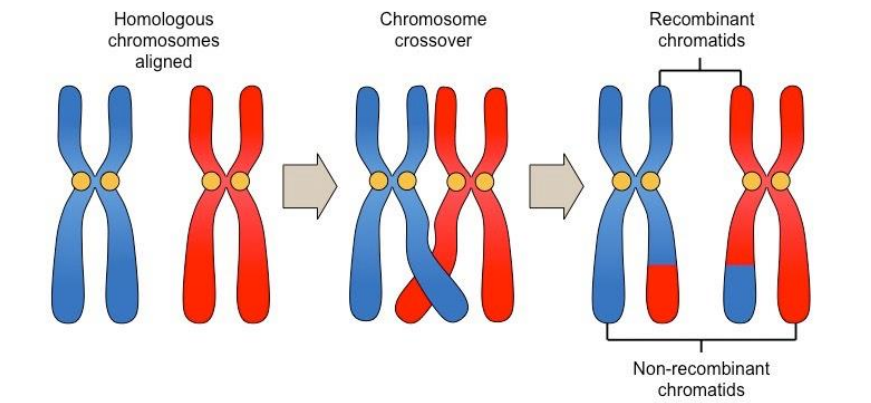D. Meiosis
➢ Production of gametes
➢ Limited to sex cells in gonads
- gonads=sex organs
- Testes in males and ovaries in females
- Made up of germ cells
➢ Produces haploid cells which then combine to restore the diploid (2n) number during fertilization
➢ 2 rounds of cell division: meiosis I and meiosis II
➢ Just like in mitosis, double-stranded chromosomes are formed during S phase of interphase
➢ Meiosis I
Prophase I
■ Nuclear membrane disappears
■ Chromosomes becomes visible
■ Centrioles move towards opposite ends of cell
■ Synapsis
● Chromosomes line up side-by-side with their homologs (counterparts)
● 2 sets of chromosomes come together to form a tetrad (aka bivalent) consisting of 4 chromatids
■ Crossing over
● Exchange of segments between homologous chromosomes
● Genetic variation
● Begins in Prophase I as homologous chromosomes line up gene by gene
● Produces recombinant chromosomes (DNA combined from each parent)
● Homologous portions of two nonsister chromatids trade placed
● Chromatids that are farther apart are more likely to cross over

- Metaphase I
■ Tetrads line up along metaphase plate
■ Random alignment–more genetic variation
● Offspring will be a combination of all 4 grandparents - ANaphase I
■ Each pair of chromatids within a tetrad separates and moves to opposite poles
■ Chromatids DO NOT separate at centromere - Telophase I
■ Nuclear membrane forms around each set of chromosomes
■ 2 daughter cells
■ Nucleus contains haploid number of chromosomes, but each chromosome is a duplicated chromosome consisting of 2 chromatids
➢ Meiosis II
- Purpose is just to separate sister chromatids
- Prophase II is the same
- Metaphase II: chromosomes move toward metaphase plate lining up in a single file, not in pairs
- Anaphase II:chromatids split at the centromere and each chromatid is pulled to opposite ends of cell
- Telophase II: nuclear membrane forms around each set of chromosomes and a total of 4 haploid cells are produced
- Meiosis I separates homologous chromosomes; Meiosis II separates sister chromatids

➢ Gametogenesis
- Spermatogenesis if sperm cells are produced
- Oogenesis if egg cell/ovum is produced
■ Produces one ovum instead of 4
■ Other 3 cells, called polar bodies get only a tiny amount of cytoplasm and eventually degenerate
■ Allows female to conserve as much cytoplasm as possible for the surviving ovum

➢ Meiotic Errors
- Nondisjunction: chromosomes fail to separate properly
■ Produces wrong number of chromones
■ Usually results in miscarriage or significant genetic defects
■ Ex. Down syndrome is a result of 3 copies of the 21st chromosome
- Translocation
■ One or more segments of a chromosome break and are either lost or reattach to
another chromosome
- Translocation